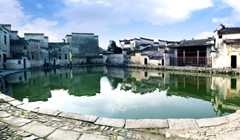Line One: World heritage & culture tour
 Introduction of the spots
Introduction of the spots|
The route presents the beautiful landscape of Huizhou and its cultural heritage as a poetic romance, so visitors may have an overall idea of the old countries from aspects of folk houses, ancestral halls, archways, old bridges, old-fashioned school, Chinese Opera, painting, medicine, crafts, business group, customs and thoughts. These are important, as it does not only show a fraction of what life was like in a traditional Chinese society during the Ming and Qing Dynasty, but also denote the inner spiritual meaning under these heritages, helping us gain a deeper and better understanding of this old but magical land. Huangshan Mountain purifies as well as deepens the Hui Culture; meanwhile Hui Culture contributes to the charms of Huangshan scenery. The ancestral halls have witnessed generations of history; with villagers living together harmoniously. The ancestral halls, the family museums, are what people residing elsewhere can only dream of. Like many other families in Huizhou, the Hu Family in Xidi also had a long story attached to it. Li was the original family name for the Hu Family, who were the descendents of Li Shimin, an emperor during the Tang Dynasty. After moving to Huizhou, they became commoners. By the end of 2000, Xidi was listed as a World Culture Heritage spot by UNESCO. Experts said these villages are the living evidence of old Chinese culture and a model of Chinese countryside architecture. Hongcun, whose map is shaped like a cow, is also on the list. The green mountains and clear water in Hongcun convey the sense of beauty to every visitor. |
★ Huangshan Mountain ★
Officially designated as one of China's top 10 scenic spots, it has charmed countless number of tourists from home and abroad. Huangshan Mountain can be regarded as an amalgamation of all the merits of other mountains: grand, steep, picturesque, and with a rich cultural heritage. Xu Xiake, a well-known geographer of the Ming Dynasty (1368-1644), once said, "When I have visited Huangshan Mountain, I don't even wish to visit others."
Blessed with a mild climate, Huangshan Mountain presents different scenery in four seasons. Its "four major marvels" are the uniquely shaped pines, oddly-shaped rocks, seas of clouds and hot springs, all of which are well known both inside and outside China.
In 1990, Huangshan Mountain was placed on the World Heritage List by the UNESCO. The year 2004 saw it rated as one of the world's geo-parks, and in 2007 it was included in China's first batch of AAAAA class tourism zones.
★ Xidi Village ★
Lying at the southern foot of Huangshan Mountain in Yixian county, Xidi Village is a key historical monument under state protection, a historical and cultural village, and one of China's top 10 most attractive towns. The village was included in the World Heritage List by UNESCO in 2000.
In Xidi, the streets and lanes are all paved with stone slabs from Shexian and the old buildings are usually of a wooden structure complete with brick walls. Sculptures of wood, stones and bricks are widely used as decorations and can be seen everywhere.
At present, a total of 124 ancient residential houses built during the Ming-Qing period (1368-1911) are still well-preserved. Most of these are wood-brick buildings with a traditional Chinese courtyard design, well-planned layout and exquisite decoration.
Xidi's well-arranged lanes, streams and buildings produce a garden-like impression, pleasing to both the eye and the mind. Because these ancient buildings are extremely good in terms of construction, layout design and decoration, they are of high value both historically and culturally. Therefore, this village is often referred to as the "treasure house of ancient residential houses" by scholars and the "most beautiful village in the world" by visitors.
★ Hongcun Village ★
Hongcun Village lies in Yixian county, set against the extending part of Huangshan Mountain.
This village is a key historical monument under state protection, a historic and cultural village of China, and one of China's top 10 most beautiful villages. In 2000 it, together with Xidi Village, was included in the World Heritage List by the UNESCO. It is also the location for the famous prize film "Crouching Tiger, Hidden Dragon".
The construction of Xidi Village began in the Southern Song Dynasty (1127-1279). Now the village contains 140 ancient buildings of the 14th to 19th century. Its water-supply system is quite unique, environmentally-friendly and surprisingly well-preserved.
The construction was designed in similarity to a baffalo's body structure: Nanhu Lake is shaped like the baffalo's belly; Moon Pond looks like it's stomach; the channel its intestine. This vivid layout of buffalo is one outstanding feature of the village. It is indubitably a wonder among World Cultural Heritage sites.
Due to such a scientific design, the local villagers are able to enjoy many conveniences in their daily lives. More importantly, a hardly-won harmony between man and nature has been realized here, and as a result the whole community seems to be brimming with life. This is why Hongcun is much more popular than its counterparts.
★ Jixi Longchuan Scenic Area ★
Jixi Longchuan, which is an old village named after the Hu people who had lived together, is a key cultural relic site under state protection with a history of more than 1600 years. By now, the villagers have stepped into its 48th generation with “Jin” in their names. Longchuan merges the natural landscape and cultural heritage together. The Hu Ancestral Hall, also named the No.1 ancestral hall in south China, is regarded as “Woodcarving Museum” and “Ethnic Arts Palace”. Yishi Shangshu, a key cultural relic site under province protection, is an authentic stone-carving archway carved during the Ming Dynasty and is well-known for its Hui styled stone-carving works.
★ Hu Ancestral Hall in Longchuan ★
Hu Ancestral Hall is a key cultural relic site under state protection. Located 12km away from Jixi County, the ancestral hall is a family ancestral hall for both Hu Fu and Hu Zongxian, two high-level officials who served in the Ming Dynasty. The hall was first built in the Song Dynasty and was later expanded in the Ming. Its distinctive Hui characteristic architecture gained it a place among other traditional Chinese architectures. Its rich cultural inference does not fail to astound every visitor. Zheng Xiaoxie, a famous architect, remarked it as a national treasure after paying a visit to the hall.
★ Hucun Village Scenic Area ★
Hucun Village is a key cultural relic site under provincial protection and is also a member of the world non-material cultural heritage. Hucun, also called Taiji Hucun, is a village with over 800 years’ history. Old bridges, pavilions, folk houses, ancestral halls and temples dot the mountains, which makes the village look like a 3D landscape painting. Taiji Hucun is viewed as “the living evidence of Huizhou traditional architectures and culture” for its thousand-year-old tree, Yinquanjie in Ming Dynasty, the tile-carved gateways, former residences of celebrities, the local Qiuqian Taige and the mysterious Yaowang Stone.
Editor: Li Jing

 What's so special about the line
What's so special about the line

